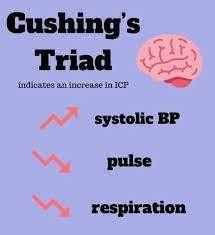The nurse is caring for a client with Cushing's triad. The nurse expects the client to have:
Irregular respirations, bradycardia, and widening pressure
Hypotension, jugular venous distention, and mufled heart sound
Fixed pupils, hypertension, and bradycardia
Bradycardia, hypotension, and bradypnea
The Correct Answer is C
Choice A rationale: Irregular respirations, bradycardia, and widened pulse pressure might indicate increased intracranial pressure.
Choice B rationale: This set of symptoms is often seen in cardiac tamponade and is referred to as the Beck’s triad and not Cushing's triad.
Choice C rationale: Cushing's triad is a set of clinical signs associated with increased intracranial pressure (ICP) and typically includes bradycardia (slow heart rate),
hypertension (elevated blood pressure), and irregular breathing patterns. Fixed pupils can also be present in some cases, but it's important to note that this triad is not always consistently present and may vary from person to person.
Choice D rationale: This set of symptoms describes symptoms of shock, not specifically Cushing's triad.

Nursing Test Bank
Naxlex Comprehensive Predictor Exams
Related Questions
Correct Answer is D
Explanation
Choice A rationale: Activates the rapid response team (RRT) - Status epilepticus is a medical emergency requiring immediate intervention. Activating the rapid response team would ensure a prompt response to the situation.
Choice B rationale: Loosens any restrictive clothing - It is important for patient safety and comfort.
Choice C rationale: Places the client in a lateral position - This is a recommended positioning to prevent aspiration during a seizure.
Choice D rationale: Prepares to administer intravenous valproate acid - Valproic acid is not the first drug during epilepsy hence this action would necessitate immediate intervention.
Correct Answer is C
Explanation
Choice A rationale: This question is not relevant to BPH, as erectile dysfunction is not a common complication of this condition. Erectile dysfunction can have other causes, such as cardiovascular disease, diabetes, medications, psychological factors, or aging.
Choice B rationale: This question is not relevant to BPH, as penile discharge is not a symptom of this condition. Penile discharge can indicate an infection, such as sexually transmitted diseases, urinary tract infections, or prostatitis.
Choice C rationale: BPH is a condition that causes enlargement of the prostate gland, which can obstruct the flow of urine and cause symptoms such as difficulty in starting or stopping urination, weak or intermittent stream, dribbling, and incomplete bladder emptying. Asking about the force of the urinary stream can help assess the severity of BPH and the need for treatment.
Choice D rationale: This question is not relevant to BPH, as sexual function is not directly affected by this condition. However, some men with BPH may experience reduced libido or satisfaction due to urinary symptoms or psychological distress.
Whether you are a student looking to ace your exams or a practicing nurse seeking to enhance your expertise , our nursing education contents will empower you with the confidence and competence to make a difference in the lives of patients and become a respected leader in the healthcare field.
Visit Naxlex, invest in your future and unlock endless possibilities with our unparalleled nursing education contents today
Report Wrong Answer on the Current Question
Do you disagree with the answer? If yes, what is your expected answer? Explain.
Kindly be descriptive with the issue you are facing.
